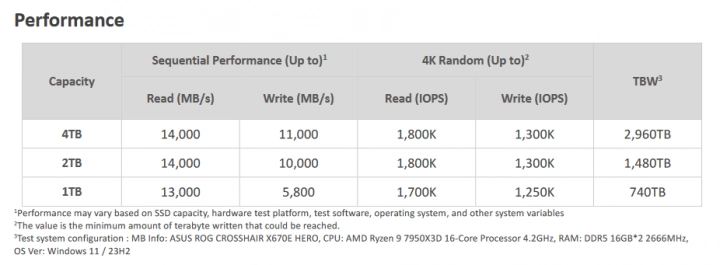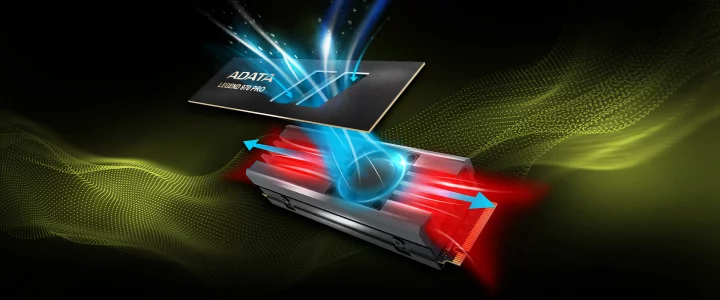In June, we wrote about the fact that new controllers for SSDs using PCI Express 5.0 to increase the maximum transfer speeds are coming to the market, so the so-called Gen5 SSDs will no longer be the domain of the Phison E26 chip. Such an SSD is now being released by Adata, whose Legend 970 Pro module brings very high performance parameters with a controller from the Chinese company InnoGrit. But it still uses active cooling, which is now integrated and does not need an extra cable.
This SSD follows on from Adata’s first Gen5 SSD, labeled the Legend 970. This achieved sequential speeds of 10GB/s, so it was one of the first relatively slower SSDs based on the Phison E26 controller. The new Legend 970 Pro model aims significantly higher.
The modules have an M.2 2280 design and will be available in capacities of 1 TB, 2 TB and 4 TB (while the previous model did not have a 4 TB variant). Perhaps they could still use Micron’s 232-layer TLC-type NAND (the manufacturer’s specifications don’t directly state it), but perhaps with a faster interface. The main change is in the controller, as this module uses the InnoGrit IG5666 controller. This is a high-end eight-channel controller supporting NVMe 2.0 and using DRAM cache and a PCI Express 5.0 x4 interface.
According to Adata, the SSD performance should go up to 14,000 MB/s in sequential read and up to 11,000 MB/s in sequential write (however, this will be when writing to the psedoSLC cache, not a sustained write speed). Also, the maximum performance in random access is stated to be high – allegedly up to 1,800,000 IOPS in reading (for modules with Phison E26 it is usually 1,400,000 IOPS) and up to 1,300,000 IOPS in random writing. These are the performances for the 4TB model, which generally also fits the 2TB version, but the 1TB module has a significantly reduced sequential write speed. See table with parameters:
The SSD has a five-year warranty and a slightly increased write guarantee, which corresponds to about 740 complete rewrites per cell – the 4TB model has a guaranteed 2960 TB of total write, then it’s 1480 TB for the 2TB model and 740 TB for the 1TB.
This is a small increase, since the Adata Legend 970 had a warranty based on 700 rewrite cycles. Comparable TLC SSDs are most often guaranteed for 600 cycles, but it is roughly comparable and the actual endurance may not differ, manufacturers usually use the same NAND chips. It is theoretically possible that the IG5666 controller has a slightly stronger implementation of LPDC correction codes, but the higher guaranteed rewrite volume is more of a purely arbitrary decision.
Always active cooling
We promised ourselves from alternative controllers that they would reduce high consumption and that these SSDs would then no longer need active coolers. Unfortunately, the Adata Legend 970 Pro does not meet expectations at this point, because the company does not state the consumption, but this SSD still has active cooling. This is solved similarly to the Legend 970 module with Phison, the module is fitted with a miniature form of a blower type cooler (as used to be common on reference versions of graphics cards) with a 20mm fan that should blow through the longitudinal passive. The SSD has a height of 18 mm with the cooler.
The change is that in the Legend 970 Pro model the fan is not powered externally (in the Legend 970 it was connected via a cable to the SATA Power connector from the computer source). The Legend 970 Pro has the fan power supply directly connected within the module itself, the electricity goes from the M.2 slot through the PCB of the module. This is more practical for installation and “prettier” from the point of view of so-called cable management.
However, there are also disadvantages. The external cable meant that it was relatively easy to reduce the fan speed with adapters with added resistance or an external controller. It won’t be so easy here (but the fan still connects to the connector with a short cable, so with a bit of tinkering it will do). It is not clear whether the cooler has automatic speed control according to the temperature in the default state. We hope so, because such small fans can be quite loud – the very small effective surface area of the blades requires very high revolutions to create a significant airflow.
The prices of the Legend 970 Pro modules have not yet been announced and they have not yet started to be sold in our e-shops.
Sources: Adata (1, 2), Tom’s Hardware
Source: www.cnews.cz




